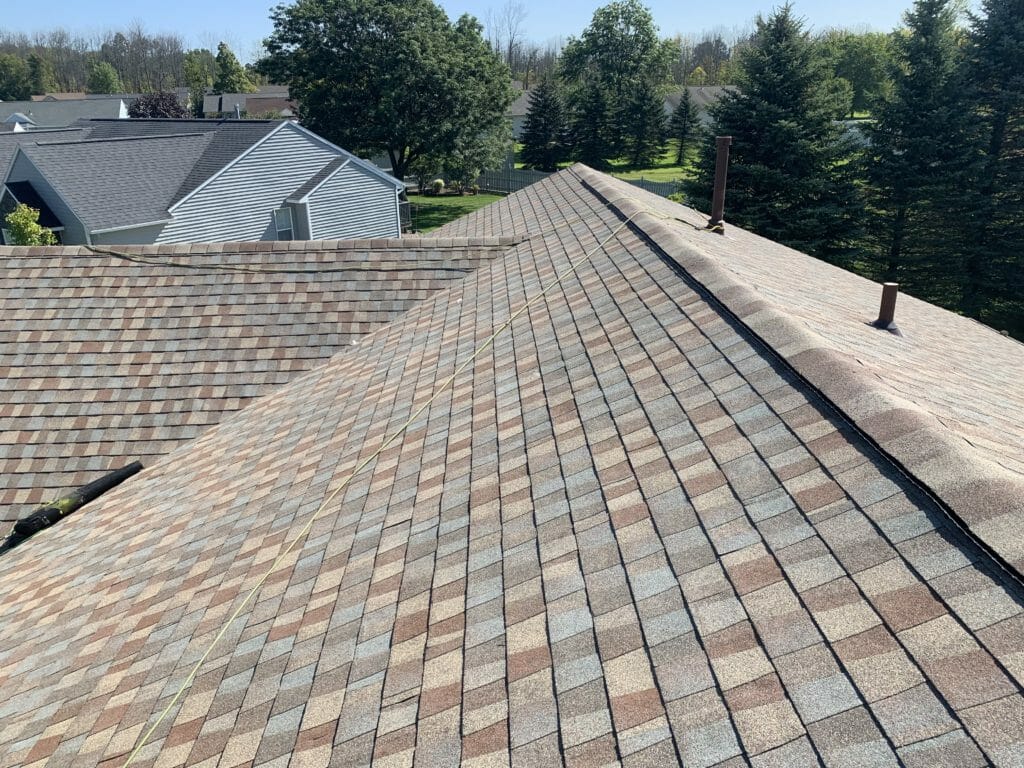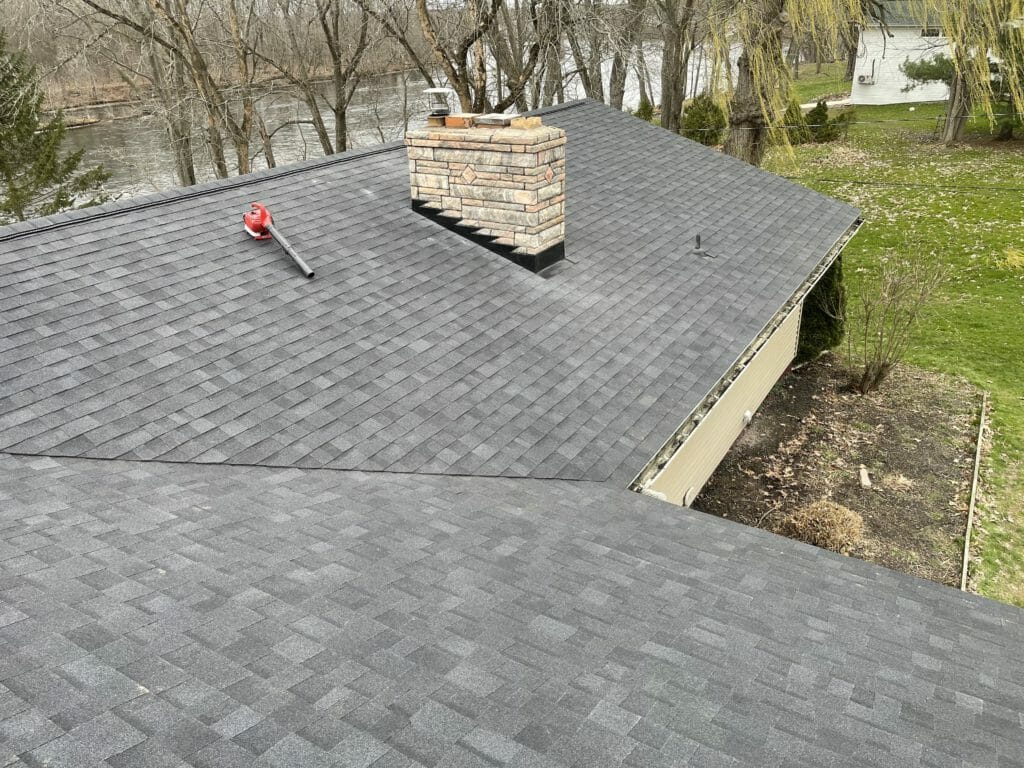Thinking about a new roof can feel overwhelming, especially when you’re juggling work, family, and everything in between. Maybe you’ve already looked into the cost. But what about the timing? How long will your house be a construction zone, and how much will it disrupt your daily routine?
If you’re a homeowner in Liverpool, NY, (or nearby), you’re not alone in wondering when it’s the right time for a roof replacement, or even just a roof repair. As a local roofing contractor, we hear these questions all the time.
The good news? We’ve got answers. In this article, we’ll walk you through how long the roof replacement process usually takes and what can affect the timeline. Whether you’re patching up a few shingles or planning a full replacement, knowing what to expect makes it way easier to plan ahead. Let’s get into it.
The Simple Answer and The Real Story
For an average-sized home using common asphalt shingles, an efficient crew can often complete the job in one full day. This baseline assumes good weather and no significant, hidden problems found during the tear-off process. This single day includes tearing off old materials, making minor repairs, and installing the new roofing system.
However, that one-day timeline isn’t a guarantee for every project. One of the biggest variables is the condition of the wooden roof deck beneath your old shingles. If the crew discovers extensive rot or damage, they’ll need to replace sections of this decking, which can add significant time to the project.
A larger home or one with an intricate roof design might take two or three days. For very large roofs with premium materials, the work could stretch from five days to a couple of weeks. Every roof is different, and these variations are what dictate how long the job will actually take.
What Determines Your Roof Replacement Time?
Several factors work together to determine the final schedule. A professional roofer looks at all of them before giving you an accurate timeline. Understanding these factors will help you see why your project’s timing might be different from your neighbor’s.
1. Your Roof’s Overall Size
This is the most direct factor affecting the timeline. A larger roof simply has more area to cover. Roofers measure roofs in “squares,” where one square equals 100 square feet of roof area.
More squares mean more old material to tear off, more new material to install, and more time on the job. Keep in mind that your home’s square footage is not the same as your roof’s size. The roof’s pitch and its various angles add surface area, meaning two homes with the same footprint can have very different roof sizes.
2. The Steepness of Your Roof
A roof’s pitch, or its steepness, plays a huge role in the replacement time. A low-slope roof with a 4/12 pitch (meaning it rises 4 inches for every 12 inches of horizontal run) is considered walkable. Crews can move about freely and stage materials with relative ease.
A very steep roof, such as a 10/12 pitch, is much harder and slower to work on. For safety, the crew must use harnesses and specialized staging equipment, such as roof jacks. This necessary safety gear means installers cannot move as quickly, slowing down every part of the process from tear-off to installation.
3. The Intricacy of the Design
How cut up is your roof? The number of facets, hips, valleys, dormers, and penetrations, such as chimneys or skylights, adds to its level of detail. A simple, straight-gabled roof is much faster to replace than one with many different angles and features.
A roof with many details takes more time because it requires a lot of precise work. Each valley, dormer, and edge needs careful cutting and flashing for a watertight seal. This attention to detail is critical for a leak-free roof, but it does slow down the process.
4. Access to Your Roof
How easily can the crew and their equipment get to your roof? Roof accessibility is a big factor. The team needs a place to park a dump truck or dumpster for the old materials and a clear path to get new materials onto the roof.
Features such as dense landscaping, fences, or closely neighboring houses can make access difficult. Limited access may mean materials have to be carried by hand over longer distances. Poor access can add hours, or even a full day, to the project timeline.
5. Your Choice of Roofing Material
The type of roofing material you select will have a huge effect on the timeline. Asphalt shingles are the most common material and are manufactured for efficient installation. Other materials require more specialized labor and time.
Premium materials, such as standing seam metal, cedar shakes, or synthetic slate, have their own specific installation requirements. They often take much longer because they are installed piece by piece with great precision. The material warranties for these premium options are often longer, reflecting their durability and installation quality.
| Roofing Material | Average Time for a 2,000 Square Foot Home | Key Considerations |
|---|---|---|
| Asphalt Shingles | 1–2 days | Most common and fastest to install. Time depends on quality of shingle. |
| Standing Seam Metal | 3–5 days | Requires specialized tools and training. Panels are custom-cut and fitted. |
| Cedar Shakes or Shingles | 4–7 days | Each shake is installed individually. Requires precision and specific nailing patterns. |
| Slate or Clay Tile | 7–14+ days | Extremely heavy material that requires a reinforced roof structure and expert handling. |
6. The Weather on Installation Day
The weather is the one factor no one can control. Roofing work can’t happen in the rain for safety reasons and to protect your home’s interior from water damage. If it rains on your scheduled day, the job will be postponed.
Even a quick pop-up shower can cause delays, as the crew must stop and cover any exposed roof decking. Extreme heat can also slow things down, requiring more frequent breaks for the crew. High winds can be a safety hazard and can interfere with the proper placement of materials.
7. The Season and Time of Year
The time of year makes a difference, primarily because of daylight hours and contractor availability. During the late spring and summer, the days are longer, giving the crew more hours to work safely. Peak roofing season can also mean that good contractors are booked far in advance.
In contrast, the fall and winter months bring shorter days and colder temperatures. When the sun goes down, work has to stop for safety. Cold weather can also make asphalt shingles brittle and harder to cut and seal properly.
Key Takeaways
You now have a much better idea of what goes into estimating a roof replacement. It’s more than just a simple question of size. Your contractor will consider all these points to give you a clear and realistic timeline for your specific project.
When you receive an estimate, it should outline the expected schedule and mention potential reasons for delays, such as adverse weather conditions or damaged decking. Open communication is important. A good roofing partner will keep you informed from start to finish.
While many asphalt shingle roofs can be replaced in a single day, this isn’t always the case. Your roof’s specific size, pitch, design, and your chosen material are the biggest drivers of the project’s length. Factors such as property access and weather also play a significant role in the schedule.
The best way to get a solid answer for your home’s roof replacement time is to have a professional roofer assess your property. They can provide an accurate and honest timeline so you can plan accordingly. This helps you prepare for the process and feel confident in the work being done.





